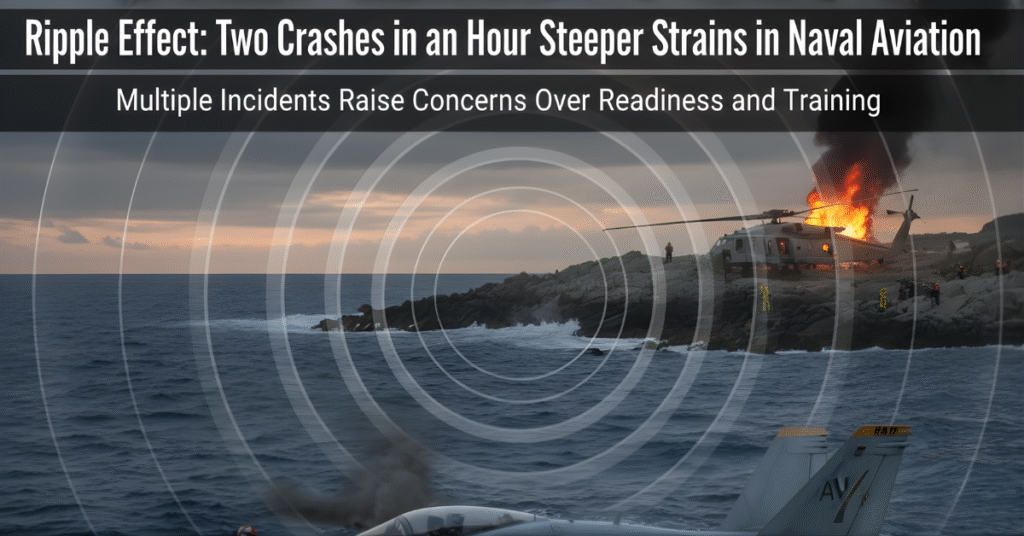The South China Sea, a region often simmering with geopolitical tension, recently witnessed a different kind of emergency. Within a single hour, two U.S. military aircraft from the USS Nimitz Carrier Strike Group were involved in separate crashes into the ocean.
While the U.S. Navy confirmed the successful recovery of all crew members—a testament to their exceptional training and rapid response protocols—the event sends a chilling signal. Two naval aviation mishaps in such rapid succession are not mere coincidence. They act as a stark warning light on the dashboard of U.S. naval power, forcing a critical examination of operational tempo, aircraft carrier safety, and military maintenance standards.
The Inherent Perils of Carrier Aviation
To fully grasp the significance of these USS Nimitz aircraft crashes, one must first understand that carrier-based flight is routinely classified among the world’s most dangerous professions. It is a high-stakes symphony of precision and power conducted on a heaving, 1,000-foot flight deck.
Pilots experience forces of nature and technology every time they launch, accelerated from zero to over 150 knots in under two seconds by a catapult. The landing, an maneuver known as an “arrested recovery,” requires snagging one of just a few wires with a tailhook. The margin for error is virtually zero. In this environment, a single point of failure—whether mechanical, human, or systemic—can have immediate and severe consequences. The occurrence of two such events points to potential vulnerabilities that demand a thorough investigation.
Decoding the Crisis: A Triad of Risk Factors
While the official U.S. Navy investigation is underway, security and defense analysts are focusing on a triad of interconnected risk factors that could explain such a cluster of incidents.
1. The Unsustainable Pressure of Operational Tempo
Warships like the USS Nimitz are the tip of the spear for U.S. forward presence, particularly in contested regions like the South China Sea. This demands a constant state of high readiness, leading to a grueling cycle of deployments, exercises, and flight operations.
This relentless pace creates a domino effect. Maintenance crews, the backbone of any air wing, work long hours in challenging conditions to meet demanding sortie schedules. Fatigue can set in, increasing the risk of oversights. The meticulous procedures required for F/A-18 Super Hornet maintenance or that of other carrier-based aircraft can be strained when the pressure to maintain mission-ready status is incessant. High tempo doesn’t just risk equipment wear-and-tear; it risks human error.
2. The Critical Role of Aircraft Maintenance and Readiness
An aircraft carrier’s ability to project power hinges on its aircraft readiness rates. However, carriers cannot carry an unlimited supply of parts. A pressing question arising from these crashes is the state of the military aviation supply chain.
Are maintenance teams facing parts shortages? Are they compelled to practice “cannibalization”—stripping parts from one aircraft to keep another airworthy? Two crashes in such quick succession could indicate a systemic issue, such as a recurring flaw in a specific component, a recently mandated maintenance procedure with unintended consequences, or the use of parts nearing the end of their service life. The airworthiness of a complex machine is entirely dependent on the quality and completeness of its maintenance.
3. The Human Element: Training and Fatigue
The U.S. Navy pilot training program is arguably the best globally. Yet, its effectiveness can be undermined by external pressures. A condensed training pipeline, or a lack of sufficient live-flight hours for junior aviators, can compound the risks of an already hazardous job.
Furthermore, military crew fatigue is a well-documented and critical safety hazard. The demanding operational schedule, with its irregular hours and high-stress environment, can lead to sleep deprivation, which impairs cognitive function, judgment, and reaction times—all essential for safe carrier operations.
A Systemic Alert, Not an Isolated Incident
Labeling these back-to-back USS Nimitz aircraft crashes as an anomaly would be a grave error. They fit a concerning pattern noted in recent years across the U.S. military, where a series of aviation accidents have been linked to deep-seated issues like insufficient maintenance funding, exhausted personnel, and the cumulative strain of prolonged high-intensity operations.
This event is a symptom of a broader challenge facing the U.S. Navy: balancing global commitments with sustainable force management.
Navigating the Aftermath: A Call for Action
The path forward from this safety alert must be deliberate and clear-eyed.
Thorough and Transparent Investigation: The Navy’s probe must be a deep-rooted cause analysis, not a search for a single culprit. It must scrutinize everything from technical data and maintenance logs to deployment scheduling and quality-of-life factors for the crew.
Strategic Re-evaluation of Demands: Pentagon and naval leadership must use this incident as a catalyst to honestly assess whether the current operational demands placed on carrier strike groups are sustainable without unacceptable risk to personnel and assets.
Reinvestment in Foundational Readiness: This means advocating for budgets that prioritize not just new ships and aircraft, but also robust spare parts inventories, ample training time, and initiatives that directly support sailor and aviator well-being.
The successful rescue of all personnel from the South China Sea was a triumph. The ultimate success, however, will be determined by our willingness to heed this warning and reinforce the fragile safety margins that have clearly been compromised. The future of naval aviation safety and the lives of those who serve depend on it.

